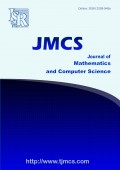Determining the Objective Value Range for a Class of Interval Convex Optimization Problems
-
2553
Downloads
-
4142
Views
Authors
Akbar Hashemi Borzabadi
- School of Mathematics and Computer Science, Damghan University, Damghan, Iran
Leila Heidarian
- School of Mathematics and Computer Science, Damghan University, Damghan, Iran
Abstract
This paper generalizes a method of determining the objective value range of
quadratic programming problems to a general class of interval convex programming ones,
where all coefficients in objective function and constraints are interval numbers. The upper
bound and lower bound of the objective values of the interval quadratic program is
calculated by formulating a pair of two-level mathematical programs. Based on the duality
theorem and by applying the variable transformation technique, the pair of two-level
mathematical programs is transformed into conventional one-level convex programming
problem. Solving the pair of convex programs produces the interval of the objective values
of the problem. Numerical results confirms the procedure of the presented approach.
Share and Cite
ISRP Style
Akbar Hashemi Borzabadi, Leila Heidarian, Determining the Objective Value Range for a Class of Interval Convex Optimization Problems, Journal of Mathematics and Computer Science, 3 (2011), no. 4, 396--402
AMA Style
Hashemi Borzabadi Akbar, Heidarian Leila, Determining the Objective Value Range for a Class of Interval Convex Optimization Problems. J Math Comput SCI-JM. (2011); 3(4):396--402
Chicago/Turabian Style
Hashemi Borzabadi, Akbar, Heidarian, Leila. "Determining the Objective Value Range for a Class of Interval Convex Optimization Problems." Journal of Mathematics and Computer Science, 3, no. 4 (2011): 396--402
Keywords
- Interval convex programming
- Interval parameters
- Two-level program.
MSC
- 90C29
- 90C25
- 90C26
- 26B25
- 49J45
References
-
[1]
S. A. Abass, An interval number programming approach for bilevel linear programming problem, International Journal of Management Science and Engineering Management, 5 (2010), 461--464
-
[2]
M. S. Bazaraa, H. D. Sherali, C. M. Shetty, Nonlinear Programming: Theory and Algorithm, John Wiley & Sons, New York (1993)
-
[3]
M. F. Cao, G. H. Huang, L. He, An approach to interval programming problems with left-hand-side stochastic coefficients: An application to environmental decisions analysis, Expert Syst. Appl., 38 (2011), 11538--11546
-
[4]
H. Ishibuchi, H. Tanaka, Multiobjective programming in optimization of the interval objective function, Eur. J. Oper. Res., 48 (1990), 219--225
-
[5]
V. I. Levin, Ordering of Intervals and Optimization Problems with Interval Parameters, Cybernetics and Systems Analysis, 40 (2004), 316--324
-
[6]
K. K. Lai, S. Y. Wang, J. P. Xu, S. S. Zhu, Y. Fang, A class of linear interval programming problems and its application to portfolio selection, IEEE Transactions on Fuzzy Systems, 10 (2002), 698--704
-
[7]
W. Li, X. Tian, Numerical solution method for general interval quadratic programming, Applied Mathematics and Computation, 202 (2008), 589--595
-
[8]
S.-T. Liu, R.-T. Wang, A numerical solution method to interval quadratic programming, Applied Mathematics and Computation, 189 (2007), 1274--1281
-
[9]
H.-C. Wu, The Karush-Kuhn-Tucker optimality conditions in an optimization problem with interval-valued objective function, Eur. J. Oper. Res., 176 (2007), 46--59
-
[10]
H. -C. Wu, On interval-valued nonlinear programming problems, J. Math. Anal. Appl., 338 (2008), 299--316

